It’s a debate that has raged among email marketers for years – single vs double opt-in, which is best?
And as with most things in life, there’s no definitive answer. Because it really depends on your long term strategy and what you need to achieve with your email marketing.
Marketers are so divided by the question that in a 2016 worldwide poll carried out by Litmus, the results were pretty close. Just over half of respondents said that single opt-in (SOI) was best. While the remaining 46.5% chose double opt-in (DOI).
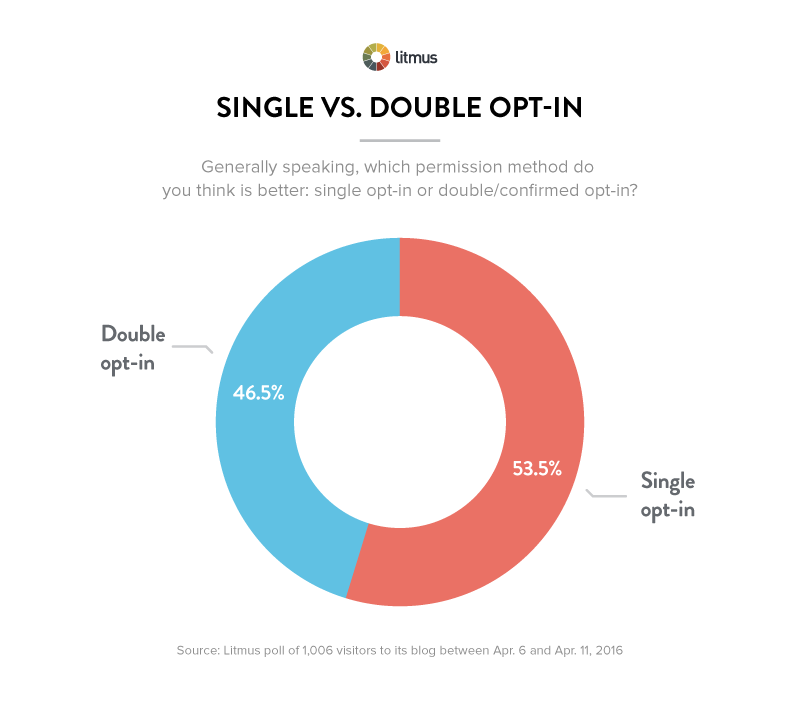
But which is right for you?
Let’s find out.
Page Contents
What’s the difference between single and double opt-in?
The key difference between single and double opt-in is whether subscribers have to confirm their subscription to your mailing list after providing their email.
Or whether they’re instantly signed up – no further action required.
With single opt-in, all you need is an email address and you can start sending email campaigns straight away. While with double opt-in, you rely on new subscribers confirming their subscription via a link before you can start emailing them.
Each has their merits, as we’re about to find out.
Single opt-in – the pros and cons
Single opt-in simply requires new subscribers to give their email address. This is usually via a sign-up form or bar on your website. Or via a dedicated landing page.
Either way, once that email address is submitted, that subscriber is on your mailing list and ready to receive your emails.
The advantages of using single opt-in
Single opt-in is the norm for the vast majority of brands. In fact, a 2013 survey by SmartInsights revealed that 94% of the top 100 online UK marketers use SOI on their website.
And it’s not hard to see why when you consider the benefits single opt-in brings marketers.
Faster list growth
When you make it easier for subscribers to join your mailing list, you speed up your list growth. Think about it – with fewer steps between a subscriber and your list, more subscribers are going to get there.
On average, mailing lists grow 20-30% faster when single opt-in is employed, compared to double opt-in. That’s according to research carried out by GetResponse.
And when you’re just starting out with your mailing list, that’s a considerable difference. Especially when you factor in the inevitable churn as contacts unsubscribe over the course of a year.
So if your number one goal is to build your mailing list, single opt-in is the way to go.
Better customer experience
Fewer steps in the sign-up process means less friction for website visitors. All they need to do is enter their email address and they’re on your list, ready to receive emails.
They don’t have to worry about checking their inbox for a confirmation email. And you don’t have to worry about losing them once you’ve got their contact details.
Easier process on mobile
Today’s world is mobile.
As of August this year, mobile devices accounted for 51.33% of internet usage worldwide. That’s according to data pulled by Stats Counter.
An easier sign-up process is better suited to mobile devices as it requires fewer steps. Users don’t need to open multiple tabs in order to complete sign-up.
And if half of the world’s population are using their phones to surf the web and potentially sign up for newsletters, having an opt-in process that’s optimised for these devices is going to benefit you.
No unconfirmed subscribers
With single opt-in, you don’t have to worry about losing subscribers. Once they’ve given you their email address, they’re on the list. (Assuming it’s a valid email address, which we’ll come to later).
A classic case study demonstrates what a huge difference this can make.
In 2009, Cirque de Soleil required new subscribers to confirm via a double opt-in message. The results showed that 20% of new subscribers failed to complete the process.
Put another way, 1 in 5 would-be subscribers never even made it onto their list. That’s despite these subscribers willingly providing their email address in the first place.
But with single opt-in, that’s not an issue.
The disadvantages of using single opt-in
It’s not all roses though. And single opt-in does come with a few drawbacks.
Poor subscriber quality
If something is easier to do, it will attract more people to do it.
But this means you could find yourself attracting subscribers that aren’t all that interested in your content. They only signed up for the new subscriber discount. Or the free ebook you were giving away.
After that, they lose interest.
What you’re left with is a list where half your subscribers rarely open your emails. And if they do, hardly ever click on the links.
Or they unsubscribe as soon as they’ve got what they wanted. Which means a high churn rate of subscribers.
Estimates vary, but one email marketer found over 20% of emails gained via single opt-in to be worthless, mainly due to lack of engagement.
All in all, it’s not a pretty picture. And if you want a more engaged audience, this is where single opt-in can let you down.
Deliverability issues
The main issue with single opt-in is that you’re more exposed to fake, invalid and spam email addresses. Whether that’s due to accidental typos or malicious spambots.
With no verification step in your sign-up process, a higher bounce rate is inevitable. After all, if you’re sending emails to addresses that don’t exist, you’re going to end up with more hard bounces.
And this negatively affects your sender reputation, which ultimate damages your deliverability.
There’s also a risk that genuine subscribers with real email addresses might mark your emails as spam. Simply because it’s easier to do than unsubscribe.
According to a 2016 Litmus spam report, 50% of consumers marked an email as spam because of a confusing or painful unsubscribe process.
So whether you’re using single or double opt-in, always make it easy for contacts to unsubscribe from your list.
Increases email marketing costs
Many email marketing platforms charge based on the number of subscribers in your list.
If a large chunk of your subscribers are unengaged or producing regular soft bounces, you’re essentially throwing money down the drain.
You could either be paying for contacts that don’t actually exist. Or paying to email people that won’t bring you any form of return.
However, maintaining a clean mailing list and purging your inactive subscribers can help solve this issue.
Requires more ongoing list maintenance
As single opt-in increases the likelihood of spam, fake and invalid email addresses getting onto your list, you’ll need to schedule regular maintenance to keep your list clean.
Which could also increase your email marketing costs.
To filter out invalid email addresses, you’ll need to add in-form verification tools to correct typos at time of sign up. Thankfully, many of these tools also identify and block bots, which helps lower your bounce rate and improve deliverability.
You’ll also need to remove inactive subscribers from your list more regularly.
Want to see a great single opt-in process in action?
Check out our Cult Beauty case study to see how it’s done. With takeaway tips to improve your single opt-in process.
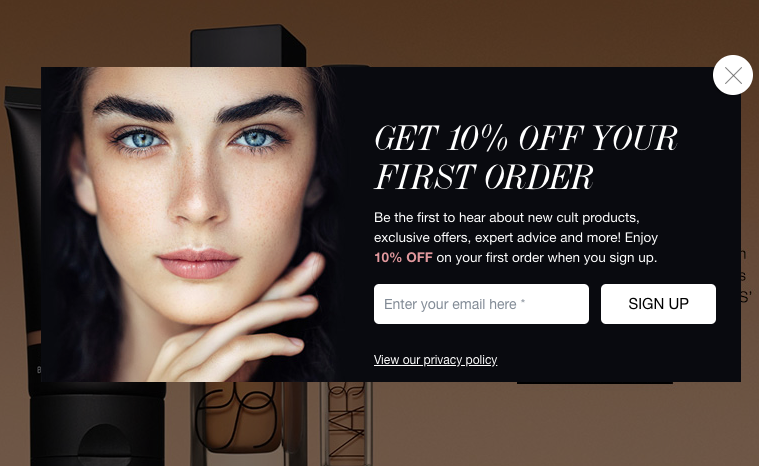
Double opt-in – the pros and cons
Compared to single opt-in, double opt-in demands more from would-be subscribers. After submitting their email in your sign-up form, they must check their inbox for a confirmation email.
Here they’ll find a link they must click to confirm their subscription. This validates a new subscriber’s contact information before they’re added to your list.
As you might expect, this comes with benefits. And drawbacks.
The advantages of using double opt-in
Single opt-in might be the norm, and might also win as the first choice for email marketers, but double opt-in is making good ground.
When Sumo analysed 106 top sites across nine different industries in 2019, they found that 79% of welcome emails were a double opt-in confirmation.
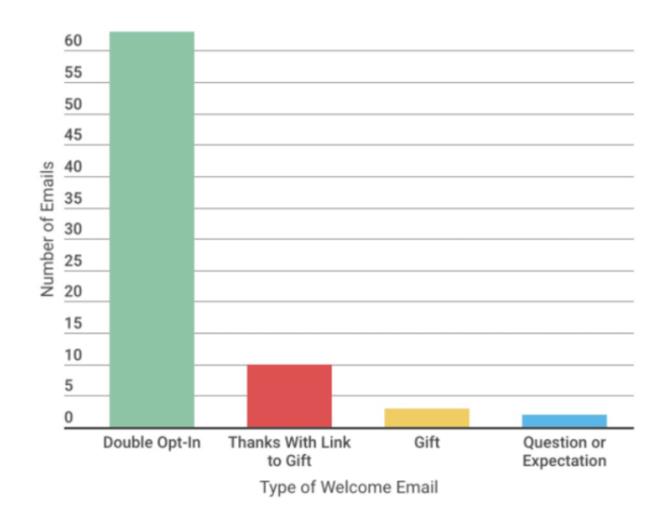
And if double opt-in is the choice du jour of highly visited websites including BMW, Men’s Fitness and CNN Money, then it’s got to have something going for it.
Better list quality
The fact that double opt-in requires a subscriber to open and click a confirmation email means it filters out many spam emails. After all, most spambots aren’t able to do this.
It also keeps invalid email addresses off your list. If a subscriber incorrectly types their email into your sign-up form, that email won’t be validated and added to your list.
So fewer spam emails, and no invalid emails either. Which keeps your mailing list clean.
You also end up with a list of more engaged subscribers. If they’ve gone to the trouble of confirming their sign-up, they’re clearly more eager to receive your emails.
And in the long run, this will provide you with more accurate subscriber data as you know they’re real people, with a real interest in your brand. It also means you’ll get more bang for your buck in terms of marketing investment.
Improved email deliverability
With fewer spam and invalid emails on your list, your bounce rate will decrease. Which will improve your sender reputation.
And as new subscribers will be looking out for your confirmation email, the first message you send is more likely to be opened. Engagement is another signal ISPs use to rate your sender reputation – the better the engagement, the better your future delivery of emails.
Your double opt-in confirmation email also serves as an opportunity to make sure your first message is added to the safe senders list. If new subscribers find your confirmation email in spam, now’s when they’ll mark it as ‘not spam’. Which is great news for your deliverability.
Increased engagement metrics
Because subscribers have to go through an extra step to get on your list, they’re likely to be more responsive to your emails. Which means more opens and more clicks.
Not only does this give you better quality data to help improve your future campaigns, it also boosts your sender reputation. Remember, ISPs use engagement signals to judge whether your emails should make it into the inbox. Or be sent straight to spam.
In 2011 Mailchimp sampled 30,000 users to see how engagement stats compared between single vs double opt-in.
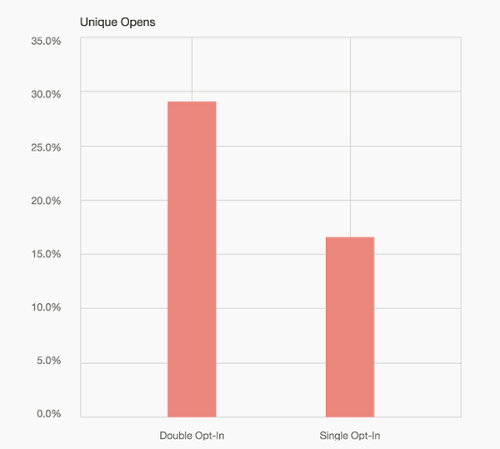
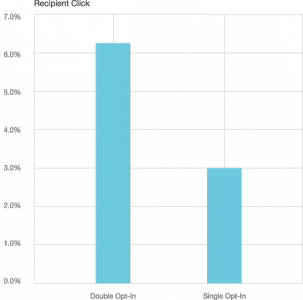
The results speak for themselves.
Double opt-in produced a 72.2% increase in unique opens. And a 114% increase in clicks compared to single opt-in lists.
Lower unsubscribe rate
The theory goes that subscribers who make the effort of confirming their sign-up are more interested in hearing from you. Which means they’re less likely to unsubscribe.
So although your list might not grow as quickly with DOI, your churn rate will slow down. And total subscriber numbers will stay more steady over the course of a year.
The disadvantages of using double opt-in
Where there are pros, there are cons. And double opt-in comes with a few of those too.
Lower conversion rates
Unfortunately, the extra step in the sign-up process guarantees you’ll lose would-be subscribers along the way.
The drop-off between those who submit an email address and those who click the confirmation link can be high.
We saw earlier how Cirque de Soleil suffered a 20% drop-off with DOI. Which means for every five people that submitted their email address, one failed to follow through with confirmation.
A study carried out by ExactTarget found this to be closer to 27%. While some email marketers expect up to a 40% failure rate.
This means you run the risk of losing interested subscribers. However, you can lower this risk by displaying a message after the initial sign-up to tell new subscribers to check their email for the confirmation link.
Or by incentivising sign-ups so that people have a compelling reason to check for your email.
Slower list growth
With subscriber drop-off comes slower list growth.
It stands to reason that if you’re losing almost a quarter of your mailing list before they’ve even fully signed up, it’s going to take you longer to grow your audience.
Longer process for subscribers
Double opt-in creates more friction for would-be subscribers. If they want to join your mailing list, they have no choice but to sign in to their inbox, find your email and click the link.
You also run the risk of potentially annoying new subscribers with the number of emails they receive when they first sign up. There’s the email with the link to confirm. Then there’s the email to confirm they’ve been subscribed to your list. Followed by your official welcome email.
To avoid this, ditch one of those emails. And confirm subscribers have been added to your list on the page displayed once they’ve clicked the link.
Single vs double opt-in and the law
Regulations on email marketing consent differ around the world. But thankfully there’s no law that states you have to use one form of opt-in over the other – the choice is ultimately yours.
For instance, in the US, you don’t need permission to email someone. However, in Europe due to GDPR, you do require explicit consent. Though single and double opt-in both fulfil this requirement. As long as you’re not pre-ticking consent boxes, either option is fine.
In Germany, double opt-in has become the norm, though it’s not a legal requirement. It’s gained popularity since GDPR came into force, as DOI is more reliable in proving legal compliance.
It’s difficult to prove that the owner of an email address entered that address into your opt-in form without any further action required. But it’s easy to prove that the email owner received and clicked on your confirmation email.
🌍 If your audience is global, international email regulations are something to be mindful of.
Don’t forget about opt-out features
While the debate between single and double opt-in methods often centers on ensuring consent and reducing spam, the legal requirement for an easy and accessible opt-out campaign is equally significant. Both forms must comply with regulations like the GDPR, and one vital component of this compliance is the ability for subscribers to opt-out of communications as effortlessly as they opted in.
Which should I choose?
When starting an opt-in email campaign, it’s important to choose between opt-in types wisely. Whether you choose single or double opt-in depends on two main factors:
- how quickly you want to grow your mailing list
- and how concerned you are about deliverability.
If you’re just starting out with your mailing list, and growth is your number one goal, choose single opt-in. It gets more subscribers onto your list without the worry of drop-off.
And if email is your sole marketing channel, then single opt-in is also a better bet. If you’re relying on just one channel then you can’t afford to lose potential customers.
On the other hand, if your mailing list is well established but you’re concerned about your sender reputation, switch on double opt-in. This will help weed out problematic emails before they get onto your list.
The same also goes if your mailing list is what makes you money. And you need a list of engaged, high quality subscribers to increase that revenue.
Whichever you choose, stick to best practices and both can work well. See these three examples of successful opt-in forms for inspiration.

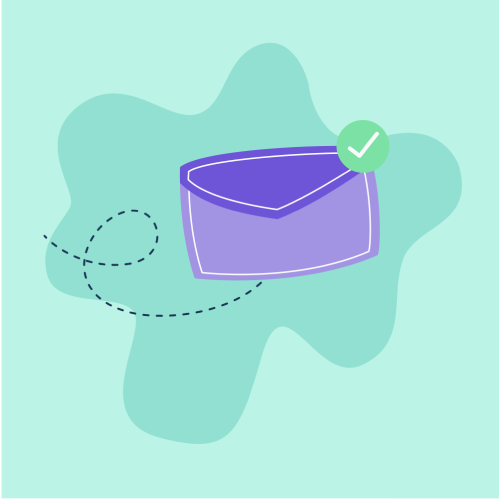
No Comments
Leave a comment Cancel